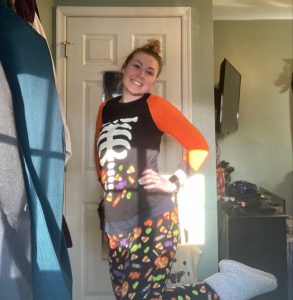Top Artifact 3

The item to archive I chose to include as my top artifact for modules 11-14 was the module 12 archive. This item to archive required the student to complete an aggression questionnaire to identify scenarios which they deemed as aggressive from a list of 25 scenarios. I enjoyed this item to archive because it surprised me. I thought I had a pretty solid idea of what aggression and aggressive behaviors looked like, but the questionnaire made me re-think what aggression truly means. I ended up changing some of my answers to the questionnaire as I completed it. As I worked my way through the questionnaire, I really began to think and reflect on what constitutes as anger versus just answering based on my first instinctual thought.
For example, I initially marked the first seven items on the questionnaire as “aggressive” behaviors. It wasn’t until I got further into the questionnaire that I began to re-think my first few responses. While the behaviors such as a spider eating a fly or two wolves fighting for leadership initially seemed aggressive to me, upon further reflection I could see how these behaviors were just instinctual for the animals and were necessary for survival in their “world”. It required me to think more complexly about aggression and helped me to see the concept in a new way, expanding on my initial surface level identifications. For the representative image for this assignment, I have included a picture of a spider entrapping a fly. The further I got into the questionnaire, the more confused I became with my initial reasoning for marking this action as “aggressive”. This one scenario really brought home the lesson I learned from this assignment: the importance of taking time to really reflect on the context and culture of a situation before eagerly judging it.
Top Artifact 2

My favorite item to archive from Modules 7-10 was from module 10. This item required me to test out the reaction of violating a social norm. I completed this task by wearing eccentric pajamas out in public and gauging the reaction of the people around me in a variety of different social settings. The settings included ODU campus, a popular brewery, the grocery store, and a casual dining restaurant (Applebee’s). I found that the setting where I received the highest volume of stares/judgement was the brewery. The brewery was located in an area that is predominantly upper-middle class, and the clientele were all perfectly made-up and wore mostly name-brand/expensive clothing/accessories. Seeing everyone’s “neat” appearance compared to my brightly colored pajamas was pretty funny. I stuck out like a sore thumb and could see the collective reaction from the other guests. It surprised me that the reaction of people from the other locations I visited were not that bad. I had a few stares here and there, but most everyone from the other locations would tend to mind their business and barely even look.
I loved this item to archive assignment because it allowed me to be at the center of my own “experiment” and it forced me to put myself out there and feel the emotions of violating a social norm. It really helped me to grasp the impact of social norms and how strong the unspoken implications are of violating them. I felt embarrassed and out of place when I noticed negative reactions from others, and it helped me to see how powerful the opinions and judgments of others can be on our appearance choices. The visual image I paired with this assignment is a picture of me in the pajamas I wore for this “experiment”. I felt this image was important to include as it gives an idea of the degree to which I broke the acceptable social norm.
Top Artifact 1

The archived item I chose as my top artifact from modules 3-6 was the item to archive from module 4. This item required the student to find a news report which depicts extreme behavior and identify how the availability heuristic can affect how we view instances of extreme behavior. We also watched the video “Are We Scaring Ourselves to Death?” and pulled a screenshot from this video that caught our attention. I really enjoyed this item to archive because it helped me apply the information from module 4 to real life situations. I feel that learning about the availability heuristic and its impact on media and public perception is very important in identifying real versus imagined risk. The article I chose that depicted extreme behavior was the story of a murder-suicide involving a mother and her baby. I have noticed a huge increase of murder-suicide news stories in the past 2 years, and I had wondered if this behavior is actually increasing or if the availability heuristic may be at play.
The availability heuristic states that what we see more often may impact our idea of how common that thing is. For instance, if we see multiple news reports of murder-suicides on TV, then we may believe that murder-suicide is a common issue. Thinking about the availability heuristic for this item to archive made me realize how this way of thinking may lead to negative consequences such as mass hysteria, misinformation, and fear. While it is important to shed light on tragic events as a result of extremes in human behavior to bring awareness to risk factors and prevention, it is also important to report factual statistics to avoid the negative consequences listed above. I found this item to archive and the resulting research to be so informative and interesting. It was my favorite assignment from the first six modules, and I feel more confident in my ability to identify when heuristics are at play because of it. I have included the screen shot above as my representative visual image because I feel it encompasses the damage the media can inflict through false narratives and the availability heuristic.